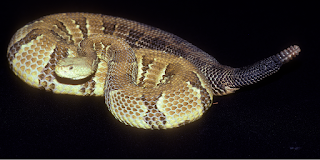Northern Copperhead Pit Viper

The northern copperhead is a large, social, venomous snake pit viper found across the eastern United States in terrestrial and semiaquatic habitats. Physical Description Copperheads are thick-bodied snakes with keeled scales. The northern copperhead has an unmarked, copper-colored head and reddish-brown, coppery body with chestnut brown crossbands. The bands are mostly hourglass-shaped, with the wider portions of the shape on either side of the snake’s body and the narrower part of the shape crossing the snake’s back over the tailbone. Young copperheads pit viper are grayer in color compared to adults and have a sulfur yellow-tipped tail, which fades over time and is lost by age 3 or 4. The northern copperhead as a vertical pupil and a single row of scales on the underside of its body after the anal plate — features also found on some venomous snakes in Virginia. The copperhead is a pit viper and, like others pit vipers, it has heat-sensitive pit organs on each side ...

